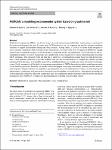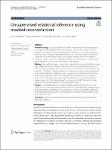Search
Author
- Jorgensen, Ed (3)
- McFadyen, Ron (3)
- Nora, El-Rashidy (3)
- Christian, Homeyer (2)
- next >
Subject
- programming (10)
- Open Access (8)
- Java (7)
- Programming (7)
- next >
Date issued
- 2020 - 2025 (293)
- 2010 - 2019 (39)
- 2000 - 2009 (2)
- 1999 - 1999 (1)
Has File(s)
- true (335)
Search Results
This open access book constitutes the refereed proceedings of the 5th Asian Supercomputing Conference, SCFA 2019, held in Singapore in March 2019.
The 6 full papers presented in this book were carefully reviewed and selected from 33 submissions. They cover a range of topics including memory fault handling, linear algebra, image processing, heterogeneous computing, resource usage prediction, and data caching. |
Video steganography approach enables hiding chunks of secret information inside video sequences. The features of video sequences including high capacity as well as complex structure make them more preferable for choosing as cover media over other media such as image, text, or audio. Video steganography is a prominent as well as the evolving field in the information security domain and significant number of video steganography methods are proposed in recent years. This article provides a comprehensive review of video steganography methods proposed in the literature. This article initially reviews various raw domain-based video steganography methods. In particular, the raw domain-based methods include spatial domain approaches such as least significant bits (LSB), transform domain-bas... |
Model-driven engineering (MDE) is an effective means of synchronizing among stakeholders, thereby being a crucial part of the software development life cycle. In recent years, MDE has been on the rise, triggering the need for automatic modeling assistants to support metamodelers during their daily activities. Among others, it is crucial to enable model designers to choose suitable components while working on new (meta)models. In our previous work, we proposed MORGAN, a graph kernel-based recommender system to assist developers in completing models and metamodels. |
Mesh-based image warping techniques typically represent image deformation using linear functions on triangular meshes or bilinear functions on rectangular meshes. This enables simple and efficient implementation, but in turn, restricts the representation capability of the deformation, often leading to unsatisfactory warping results. We present a novel, flexible polygonal finite element (poly-FEM) method for content-aware image warping. Image deformation is represented by high-order poly-FEMs on a content-aware polygonal mesh with a cell distribution adapted to saliency information in the source image. |
Inversion of radiative transfer models (RTMs) is key to interpreting satellite observations of air quality and greenhouse gases, but is computationally expensive. Surrogate models that emulate the full forward physical RTM can speed up the simulation, reducing computational and timing costs and allowing the use of more advanced physics for trace gas retrievals. In this study, we present the development of surrogate models for two RTMs: the RemoTeC algorithm using the LINTRAN RTM and the SCIATRAN RTM. We estimate the intrinsic dimensionality of the input and output spaces and embed them in lower dimensional subspaces to facilitate the learning task. Two methods are tested for dimensionality reduction, autoencoders and principle component analysis (PCA), with PCA consistently outperfo... |
Stochastic dynamical systems in which local interactions give rise to complex emerging phenomena are ubiquitous in nature and society. This work explores the problem of inferring the unknown interaction structure (represented as a graph) of such a system from measurements of its constituent agents or individual components (represented as nodes). We consider a setting where the underlying dynamical model is unknown and where different measurements (i.e., snapshots) may be independent (e.g., may stem from different experiments). |
The first section of the book presents models and simulations for the analysis of the behavior of some parts of the human body. The second section of the book presents some mathematical and numerical methods to inte‐ grate different types of differential equations. The third section of the book presents different problems of heat transfer where fluids are involved. The final section of the book presents some models and techniques for turbulent flows. |
As a high-impact educational practice, service-learning has demonstrated success in positively influencing students’ overall development, and much work has been done on investigating student learning outcomes from service-learning. A particular direction is to model students’ learning outcomes in the context of their learning experience, i.e., the various student, course, and pedagogical elements. It contributes to a better understanding of the learning process, a more accurate prediction of students’ attainments on the learning outcomes, and improvements in the design of learning activities to maximize student learning. |
In this paper, we study the nonuniform fast Fourier transform with nonequispaced spatial and frequency data (NNFFT) and the fast sinc transform as its application. The computation of NNFFT is mainly based on the nonuniform fast Fourier transform with nonequispaced spatial nodes and equispaced frequencies (NFFT). The NNFFT employs two compactly supported, continuous window functions. For fixed nonharmonic bandwidth, we show that the error of the NNFFT with two sinh
-type window functions has an exponential decay with respect to the truncation parameters of the used window functions. As an important application of the NNFFT, we present the fast sinc transform. |
Being able to provide counterfactual interventions—sequences of actions we would have had to take for a desirable outcome to happen—is essential to explain how to change an unfavourable decision by a black-box machine learning model (e.g., being denied a loan request). Existing solutions have mainly focused on generating feasible interventions without providing explanations of their rationale. Moreover, they need to solve a separate optimization problem for each user. |










